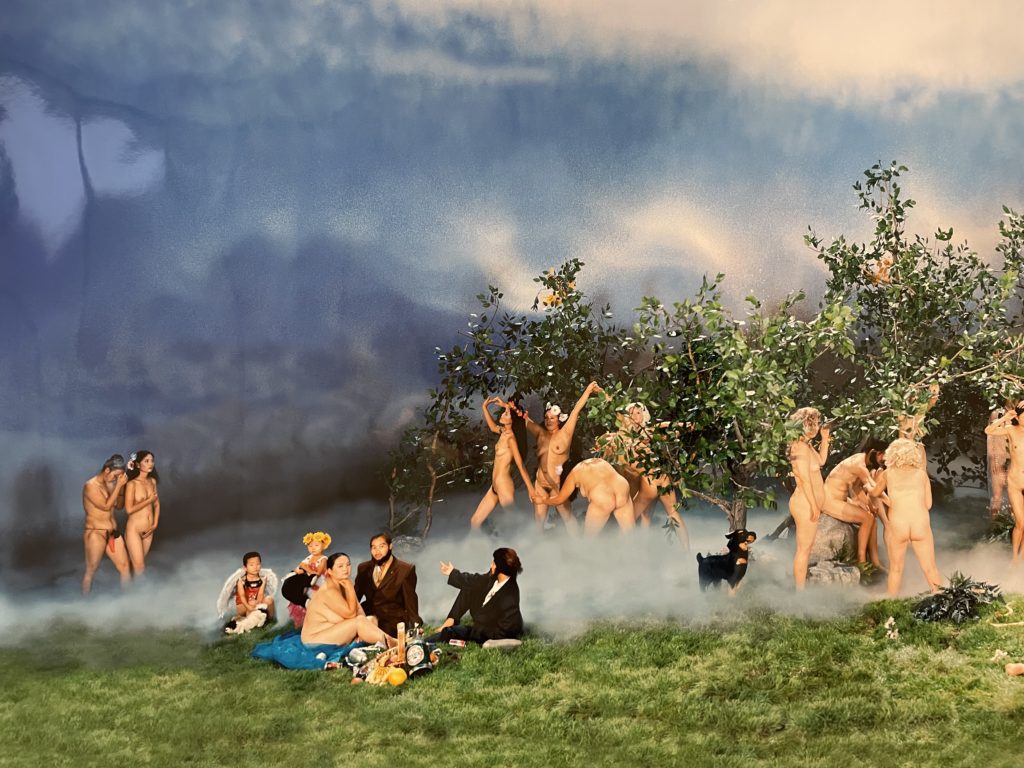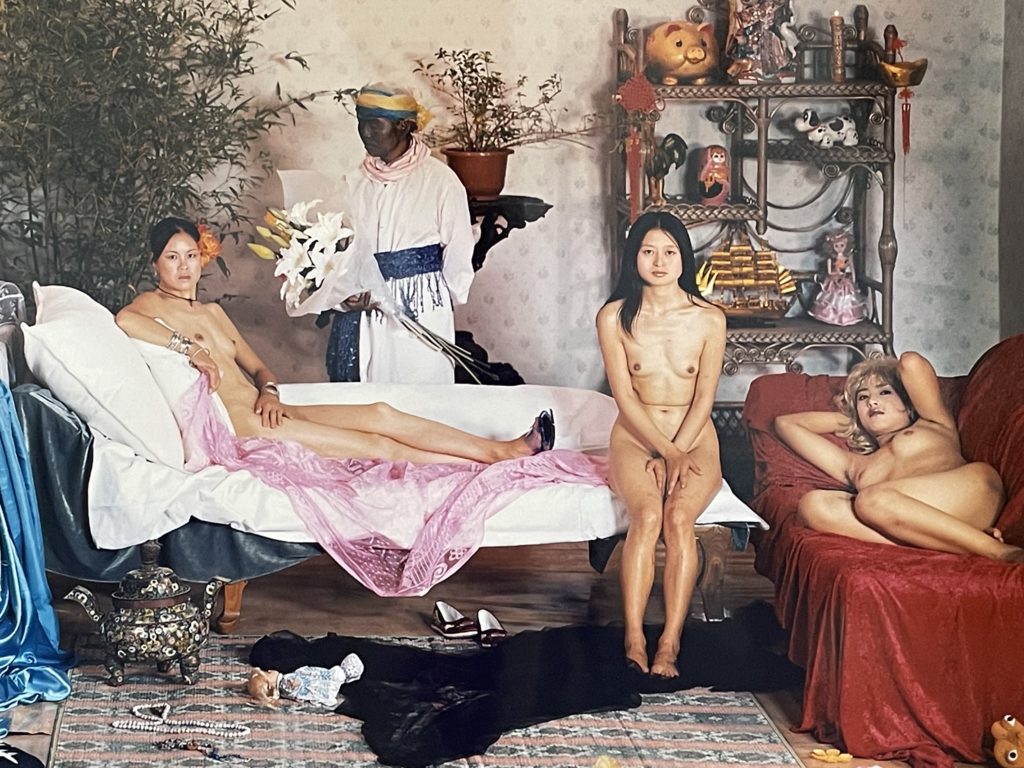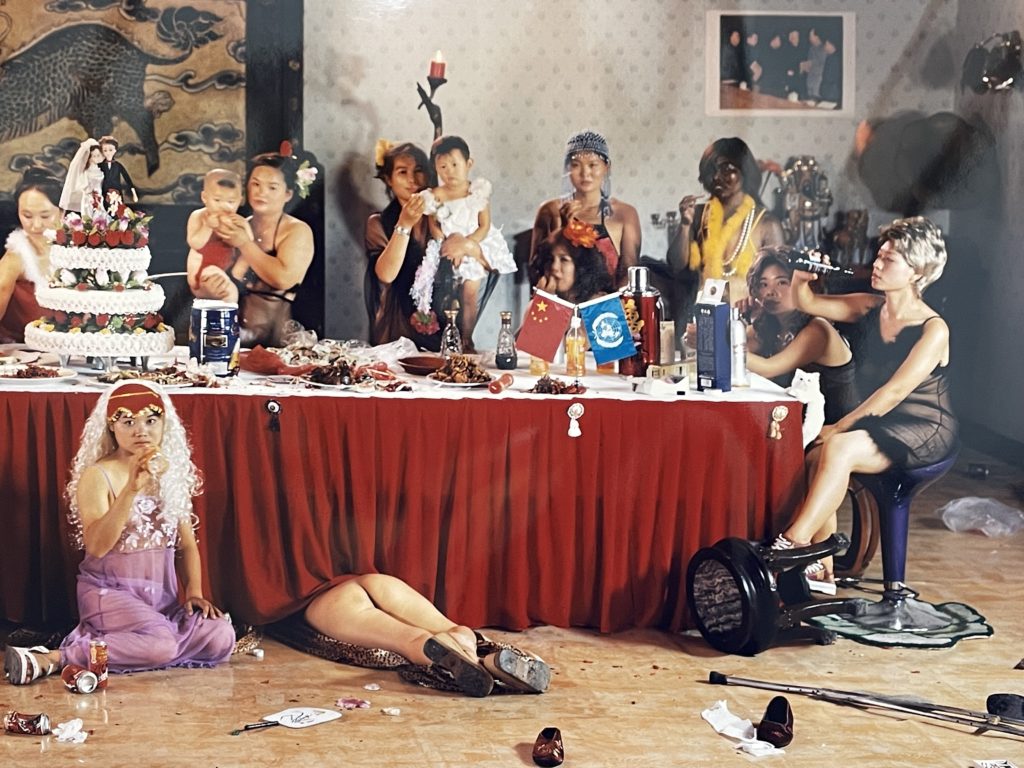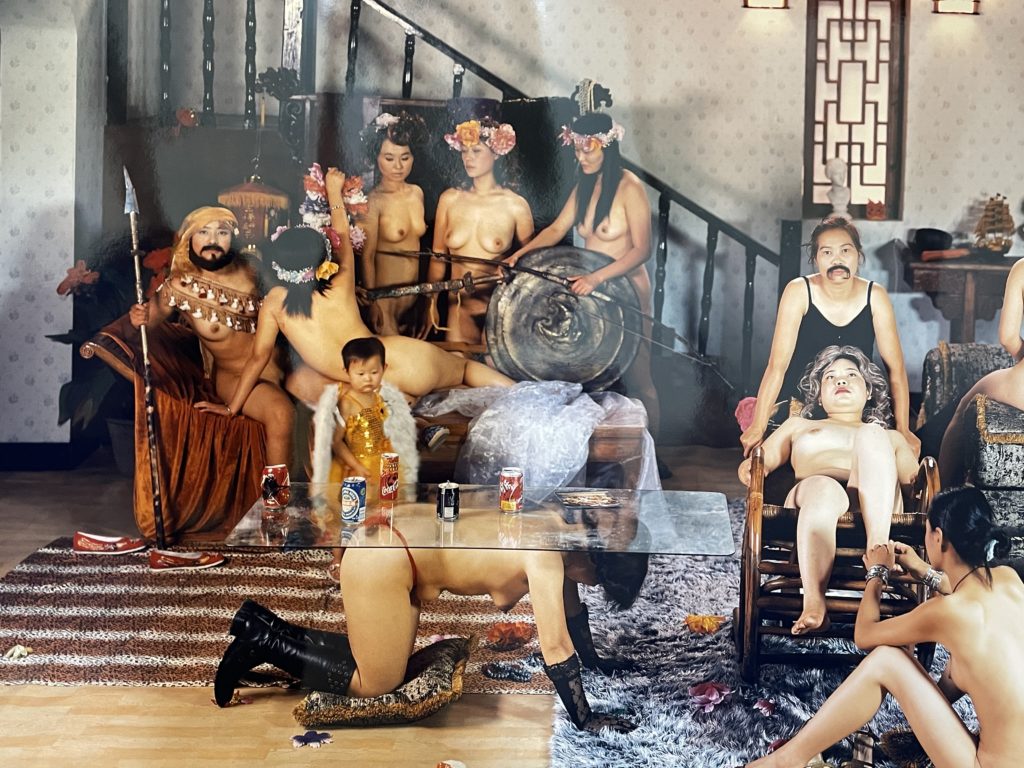Category Archives: Allgemein
ZKM Ausstellung Renaissance 3.0
Renaissance 3.0, dieser Ausstellungsname bezieht sich auf 3 uns bekannte Zeiten einer Renaissance, der Neugeburt einer Kultur. Die erste wird die Arabische Renaissance zwischen 800 -1200 genannt. Im arabischen Raum wurden Musik Maschinen und Roboter ähnlichen Figuren geschaffen.
Die zweite Renaissance bezieht sich auf die Italienische zwischen dem 15. Und 17. Jahrhundert. Hier wurden Perspektive, Grundlagen der Naturwissenschaften, die menschliche Anatomie und komplexere mechanische Maschinen erdacht. Die dritte Renaissance bezieht sich auf unser Zeitalter. Es ist die digitale Renaissance. Hier findet eine Politisierung und Verwissenschaftlichung der Kunst statt. Kunst und Wissenschaft verwenden gleiche Tools, das gleiche Handwerkszeug. Künstliche Intelligenz und Robotic, Machine Learning, Big Data hinterfragen nachhaltig die Rolle der Kunst, ihre Definitionsfähigkeit und generelle Rolle in der Kultur.
Wir nähern uns einer Kunst die von technischen Experiment oder wissenschaftlichen Experiment kaum zu unterscheiden ist. In der Ausstellung Renaissance 3.0 werden Exponate von Forschern, von Künstlern und von Designern auf einer Ebene gezeigt.
Dort findet sich das Kunstwerk von Tomas Saraceno. Erst studierte er Architektur in Buenos Aires, im Anschluss Skulptur an der Kunstuniversität Escuela Superior de bellas Artes Ernesto de la Carcova. Mit dem um die Jahrtausendwende aufgetretenen wirtschaftlichen Zusammenbruch in Argentinien siedelte Saraceno 2001 nach Deutschland um. An der Städelschule in Frankfurt besuchte er ein postgraduierten Studium bei Thomas Bayerle und Ben van Berkel. Dann besucht er Kurse von Olafur Eliasson und Hans Ulrich Obrist in Venedig und nimmt 2009 am International Space Studies Program im NASA Ames Research Center, Silicon Valley, Kalifornien, teil. Im ersten Jahrzehnt des neuen Jahrtausends zieht es ihn nach Berlin und er kauft 2012 das ehemalige Agfa Fabrik Gelände in der Rummelsburger Bucht.

Saraceno erforscht die Welt der Spinnen.
Arachnophilia ist eine interdisziplinäre, forschungsgetriebene Gemeinschaft. Sie ist aus der mehr als 10-jährigen Zusammenarbeit des Künstlers mit Menschen, Spinnen und ihren Netzen hervorgegangen. Mit Forschern der TU Darmstadt entwickelte Saraceno den Spider/Web Scan, ein neuartiges, lasergestütztes tomografisches Verfahren, mit dem erstmals präzise 3-D-Modelle komplexer Spinnennetze erstellt werden konnten. Nggàm dù, ein Webportal der Spinnen-Wahrsager von Somié, Kamerun, meditiert über die Möglichkeiten wechselseitiger, interkultureller und inter- und intraspeziesischer Beziehungen.
Die hochentwickelten sensorischen Fühler ermöglichen nicht für Menschen problemlos zu entschlüsselnde und nachahmbare Kommunikationsformen. Saraceno hat einen ganzheitlichen Blick auf das Leben von Mensch und Tier.

Der Mensch, der sich als überlegenes Lebewesen definiert, ein Lebewesen, das sich selbst zur überlegenen Kreatur auf dem Planeten ernannt hat und andere Lebensformen und Kreaturen sich untertan macht. Saraceno teilt diese Überzeugung nicht. Er schafft Kunstwerke, die Besonderheiten anderer Lebensformen auf unserem Planeten in diesem Fall Spinnen vermitteln. Seit mehr als zwei Jahrzehnten hat Saraceno Projekte initiiert, die darauf abzielen, die Mitgestaltung der Atmosphäre zu überdenken.
Wir sollen erkennen, dass wir zusammen leben müssen, dass wir Teil der natürlichen Lebenswelt sind, nicht deren Dominator. So untersucht er die Spannkraft, den Aufbau, die Widerstandsfähigkeit von Spinnennetzen. Im europäischen Raum kennen wir 2 dimensionale Spinnennetze, es gibt aber in anderen Regionen Spinnenformen, die hochkomplizierte 3 dimensionale Netzkörper spinnen. Da Spinnen ziemlich schlecht sehen, verfügen sie über ausgezeichnete Schwingungssensoren. Sie kommunizieren über Schallveränderungen und über sehr leichte Vibrationen.
Es ist ein weisser Raum mit übergrossen 3 dimensionalen Spinnennetzen. Einige Schnüre sind über Tonabnehmer mit einem Computer verbunden und erzeugen Geräusche, Töne. Wer die Saiten anschlägt oder daran entlang fährt, hört Echos, die Paarungstöne eine bestimmten Spinnenspezies. 18 verschiedene Soundskulpturen swingen in verschiedenen Frequenzen. Dafür hat Saraceno gut 3,5 KM Schüre in einem weißen Raum verlegt. Nur jeweils 5 Besucher dürfen gleichzeitig in den Raum hinein und können die Saiten zum Schwingen bringen und die Töne und Echos hören. Ein ganzheitliches Erleben in einer ruhigen und besonnenen Installation findet statt. Hier muss nicht gesprungen oder gehüpft werden. Es geht um ein vorsichtiges Explorieren der Netze, ihrer Fragilität und um die Suche nach Tonsträngen.
Vorsichtig werden sie angeschlagen und die BesucherIn geht dem ton nach. Verbindet sie mit anderen Geräuschen und lässt die Klänge in sich nachhallen.
Ein Video von Tomás Saraceno: Building “future flying cities” with spiders,
San Francisco Museum of Modern Art
Beitrag von Ursula Drees
Is Anybody Home?

Es beginnt damit, dass ein Gast auf die Bühne tritt, mit schimmernden Schlafanzug bekleidet und sich vorstellt. Im Februar, als ich da war, war es Zarah Kofler. Per Live Stream spricht sie mit einem Performer. Der sitzt noch in der Umkleide und ist nicht fertig, kann nicht auf die Bühne kommen. Sie möge bitte beginnen.

Er entspinnt sich ein Gespräch über Albträume, Ängste, Hoffnungen. Wechselseitig wird Innerlichkeit offenbart. Erst du, dann ich, dann wieder du, dann ich. Und ein Vertrag wird vorgelesen. Der besagt, dass der Gast für den Zeitraum von 1,5 Stunden entspannt im Bett liegen kann, seine Wünsche, Ängste und Träume, Bedenken und andere Stimmungen werden gehört, betrachtet, verarbeitet und das Gob Squad Team gibt sich Mühe, alles zu beheben. Der Gast ist einerseits Gast, aber auch Performer. Von der Bühne führt eine Rampe hoch in den Zuschauerraum und drüber hinweg. Dort steht ein Bett. Wunderbar plüschig, gemütlich, ein bisschen Dampf schwebt vom Boden hervor. Der Gast legt sich hinein und muss sich überraschen lassen. Es ist privat und wie zu Hause, aber doch ist man Teil des Geschehens, nein eigentlich die Hauptperson. Merkwürdigerweise auch die einzige Person, die bis zum Schluss vor Ort ist. Alle anderen sind im Stream.

Es ist ein Reise. Fragen wollen beantwortet werden. Das Gob Squad Team versucht es. Es entsteht ein überraschender Dialog. In vielen Fällen durch sanftmütige Überlegungspausen geprägt. Manchmal wird es tiefsinnig, philosophisch sogar, manchmal ist es Alltäglich. Banal und wie immer. Zwei der Performer gehen durch die Stadt und versuchen den Rätseln des Gastes auf die Spur zu kommen. Und in der Tat, einer findet einen Schlüssel. Wie durch ein Wunder ist es der Wohnungsschlüssel des Gastes.

Erst der eine, dann der andere Performer erkunden das Leben des Gastes im Bett der Volksbühne, als sei es ihr eigenes. Es zumindest sind davon überzeugt, dass es das Ihrige ist. Es ist ein Raten, ein Vorhersehen, ein spontanes daneben Liegen. Es ist aber auch ein Eindringen in die Privatsphäre eines Fremden. Was kann noch mehr Persönlichkeit ausstrahlen als die Wohnung. Daher sind die Performer mit dunklen Augenringen, weisser Haut und sanften rosa Lippenstift geschminkt, haben gelbe oder blaue Fingernägel. Sie erinnern an Clowns, aber auch an Vampire.
Erst am Ende vermengen sich die parallelen Spielorte zu einem. Es ist spannend, manchmal langweilig, manchmal lustig und immer echt.
Gob Squad ist ein deutsch-britisches Performance-Kollektiv, das sich 1994 an der Nottingham-Trent-Universität zusammenfand. Zu den ständigen Mitgliedern gehören Johanna Freiburg, Sean Patten, Berit Stumpf, Sarah Thom, Bastian Trost und Simon Will.
Nächster Termin: 17 Mar 2023 Berlin, Germany, Volksbühne am Rosa-Luxemburg-Platz
Konzept & Regie: Gob Squad, Sounddesign: Catalina Fernandez, Isabel Gonzalez Toro, Videodesign: Miles Chalcraft, Licht: Frank Novak, Bühne: Nina von Mechow, Gob Squad, Prater Studios: Nina von Mechow, Leonard Neumann, Kostüme: Sarah Thom, Ingken Benesch, Frank Salewski, Dramaturgie: Johanna Höhmann, Christina Runge.
Mit jeweils drei der folgenden Performer:innen: Mira Partecke, Sean Patten, Sharon Smith, Berit Stumpf, Sarah Thom, Bastian Trost, Simon Will. Und (einem:r der folgenden Gäste): Vandross Diogo Valéria Alage, Josefin Fischer, Arda Görkem, Rojin Haddad, Janoushka Kamin, Zarah Kofler, Lilith Krause, Fabio Mazzocchi, Yu Sun.
Premiere am 15. Dezember 2022
Dauer: 1 Stunde 30 Minuten, keine Pause
Beitrag von Ursula Drees
Im Zentrum für Kunst und Medien gab es die Ausstellung Bio Medien zu sehen.
Es handelte sich im Wesentlichen um Exponate, die das generative Wesen von Biologie aufgreifen und in mediale Installationen übersetzen. Es fanden sich sowohl Robotik, Machine Learning als auch durch Künstliche Intelligenz generierte Installationen.
„Infinity“ von Universal Everything stand gleich am Anfang der Ausstellung. Auf der Leinwand ziehen jede Menge phantasievoller Kreaturen vorbei. Sie sind durch Algorithmen gesteuert. Mit Kinect- Kameras werden oder wurden Passanten aufgenommen, deshalb sind die Bewegungen der Kreaturen so wunderbar individuell. Die Besucher*innen werden geortet. Bei Annäherung an die Projektion, werden die Kreaturen grösser, sie können auch zurück weichen oder es kommen neue Kreaturen heraus. Das musse die Besucher*in glauben, denn es lässt sich aber nicht durch Anschauung kontrollieren. Es gibt keine nachvollziehbaren Feedbacks auf das Handeln. Diese wundervolle Parade von unterschiedlichen Kreaturen zieht von links nach rechts vorbei. Alle sind bunt und unterscheiden sich in ihrer elastischen und wabernden Bewegung voneinander. Manche sind riesig, andere sind schmal und schlank. Dazwischen gibt es alles.
Die Kreaturen äußern sich durch verschiedene Klänge (-kanal Lautsprechersystem). Diese Äußerungen sind an die Positionen im Raum von Besucher*innen gebunden.
Das Ganze wurde mit Unity hergestellt, die Stereophonie wird durch die Software Zirkonium gesteuert.
Einige Klassiker waren auch zu finden wie „A-Volve“ von Christa Sommerer and Laurent Mignonneau, ein Werk das auf der Ars Electronica in Linz im Jahr 1994 mit dem Prix Ars Electronica ausgezeichnet wurde. Es ist Kult.
Es lohnt sich immer mal wieder beim ZKM vorbei zu schauen. Die Ausstellungen sind immer überraschend. Auch wenn die Ausstellung Biomedien vorbei ist, es kommen schon immer starke Ausstellungen hinterher.
Beitrag von Ursula Drees
Nach dem Tod seines Vaters wurde Wang Qingsong gezwungen, seine Familie zu unterstützen. Er arbeitete jahrelang als Bohrer für eine Ölgesellschaft, bevor ihn seine Mutter ermutigte, mit Mitte zwanzig ein Kunststudium zu beginnen. Das war zu dieser Zeit ungewöhnlich. Die meisten seiner Kommilitonen in der Abteilung für Malerei an der Kunstakademie von Sichuan hatten Eltern, die traditionelle Künstler waren, und keine Arbeiter wie seine Eltern. Anstatt nach seinem Abschluss auf das Ölfeld zurückzukehren, zog er nach Peking, wo er die Fotografie in seine Arbeit einbezog.
Zunächst druckte er Bilder, die er aus Zeitschriften eingescannt hatte, auf Seidensamt, bevor er sich 1996 Photoshop aneignete, um digital überlagerte Werke zu schaffen. Nachdem er mit der digitalen Technologie nicht mehr einverstanden war, begann er im Jahr 2000 mit einem Pekinger Filmstudio zusammenzuarbeiten, wo er Modelle in aufwendigen Tableaus besetzte und inszenierte, die er in weitläufigen Panoramaszenen fotografierte.
Seine Panoramawerke wie Requesting Buddha Series No.1 und China Mansion sind gespickt mit Verweisen auf kanonische Werke der westlichen Kunstgeschichte, von Sandro Botticellis Geburt der Venus (1484 – 1486) über Edouard Manets Olympia (1863) bis zu Man Rays Ingres‘ Violine (1924). Diese Werke vereinen ein Übermaß an fremden Elementen zu schwungvollen, manchmal ostentativen Visionen des neuen China.
Die Panoramabilder sind voller Farbgewalt. Sie sind saturiert und eine verrückte Lebensfreude wird vermittelt.



In China Mansion wird das Geschehen kommentiert, eher wohl interpretiert. Es wird gegessen, gevöllert sogar, die Frauen sind leicht bekleidet, oft verkleidet, betrinken sich, hängen rum, manche so betrunken, dass sie unter dem Tisch landen. (Leonardo da Vinci, Das Abendmahl, 1494–1498).
Oder Raffaels Die drei Grazien. Hier stehen sie vor einem Paravan, um sie herum andere Interpretationen der grossen westlichen Malkultur. Wie zum Beispiel Amedeo Modigliani´s „Liegender Akt“ (Nu couché). Gleich daneben liegt Edouard Manets berühmtestes Gemälde, die skandalumwitterte „Olympia“ (1863). Das Umfeld hat ausgeprägten Bordellcharacter. Die Darstellungen sind übertrieben, fast schon lächerlich. Und gleichzeitig werden der westlichen Betratchter*in bewusst, dass die Kunst eine Vielzahl von nackten Musen zu offerieren hat.






Als Betrachterin macht es Spass, das kunstgeschichtliche Wissen zu testen. Und dabei festzustellen, dass viele Motive zwar bekannt erscheinen, aber eine genaue Künstlerzuordnung nicht hinhaut. Dabei ist alles schon mal gesehen worden. In Katalogen, im Internet, vielleicht in den vielen Museen, die man im Laufe der Zeit gesehen hat.
Wie muss diese Fotografie auf andere Kulturen wirken? Was sagt das über die westliche Kultur aus? Was sagt es über die heutige Chinesische Kultur aus? Alles wird zitiert und verwäscht sich in der globalisierten Welt. Alte Traditionen bilden die heutige Welt nicht mehr ab.
Beitrag von Ursula Drees
Der CommAward, der vom Comm Club Bayer ausgelobt wird und das schon seit einigen Jahren sehr erfolgreich, hat die Preise vergeben. Plantasia, ein interaktiver Erlebnisraum hat in den Kategorien „Raum, Design, Interaction Talent und Sound“ durch Qualität und Finesse überzeugt.
So auch der Communication Arts Interactive. Seit 1959 veröffentlicht Communication Arts die besten Arbeiten der visuellen Kommunikation aus aller Welt. Fragt man einen Kreativdirektor, welche Wettbewerbe die einflussreichsten sind, so steht Communication Arts ganz oben auf der Liste. Hier gab es eine Auszeichung.





Plantasia, ein interaktiver Erlebnisraum der Studioproduktion EventMedia, Hochschule der Medien, Stuttgart.
Selbstgeschaffene Künstlichkeit umgibt den Menschen. Wir leben in Wohnkästen, bewegen uns in Blechpanzern auf betoniertem Grund. Wir zerstören unseren natürlichen Lebensraum. Mit Plantasia tauchen Besucher:innen in eine unberührte, magische Naturwelt ein. Damit wird ein Zeichen für eine befreite neue Natur gesetzt.
Im Zuge unserer Kooperation mit dem ZSW liefert die Gruppe der Studioproduktion EventMedia eine Interpretation zum Thema „junge Energie“. Selbstgeschaffene Künstlichkeit umgibt den Menschen. Wir leben in Wohnkästen, bewegen uns in Blechpanzern auf betoniertem Grund. Wir zerstören unseren natürlichen Lebensraum.
Wir gratulieren für die vielen Auszeichnungen und Preise.
Beitrag von Ursula Drees

